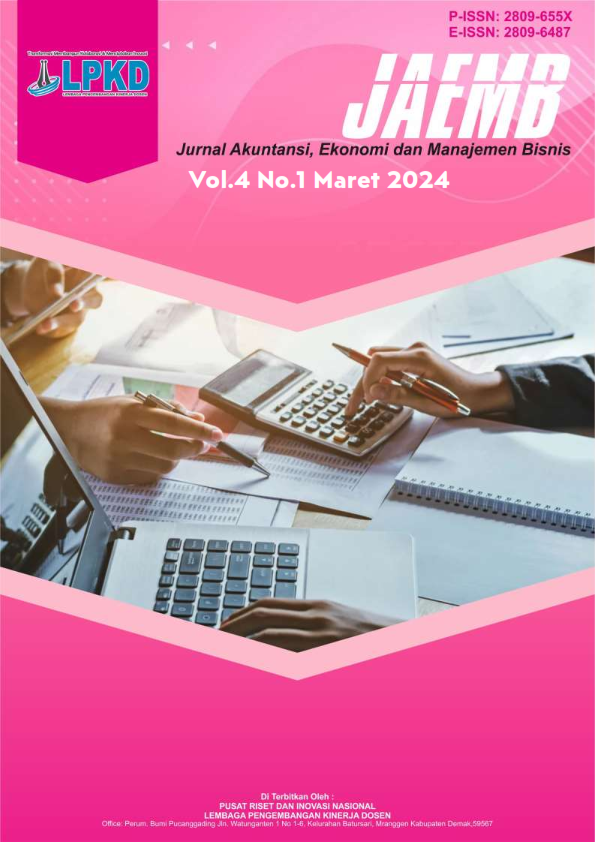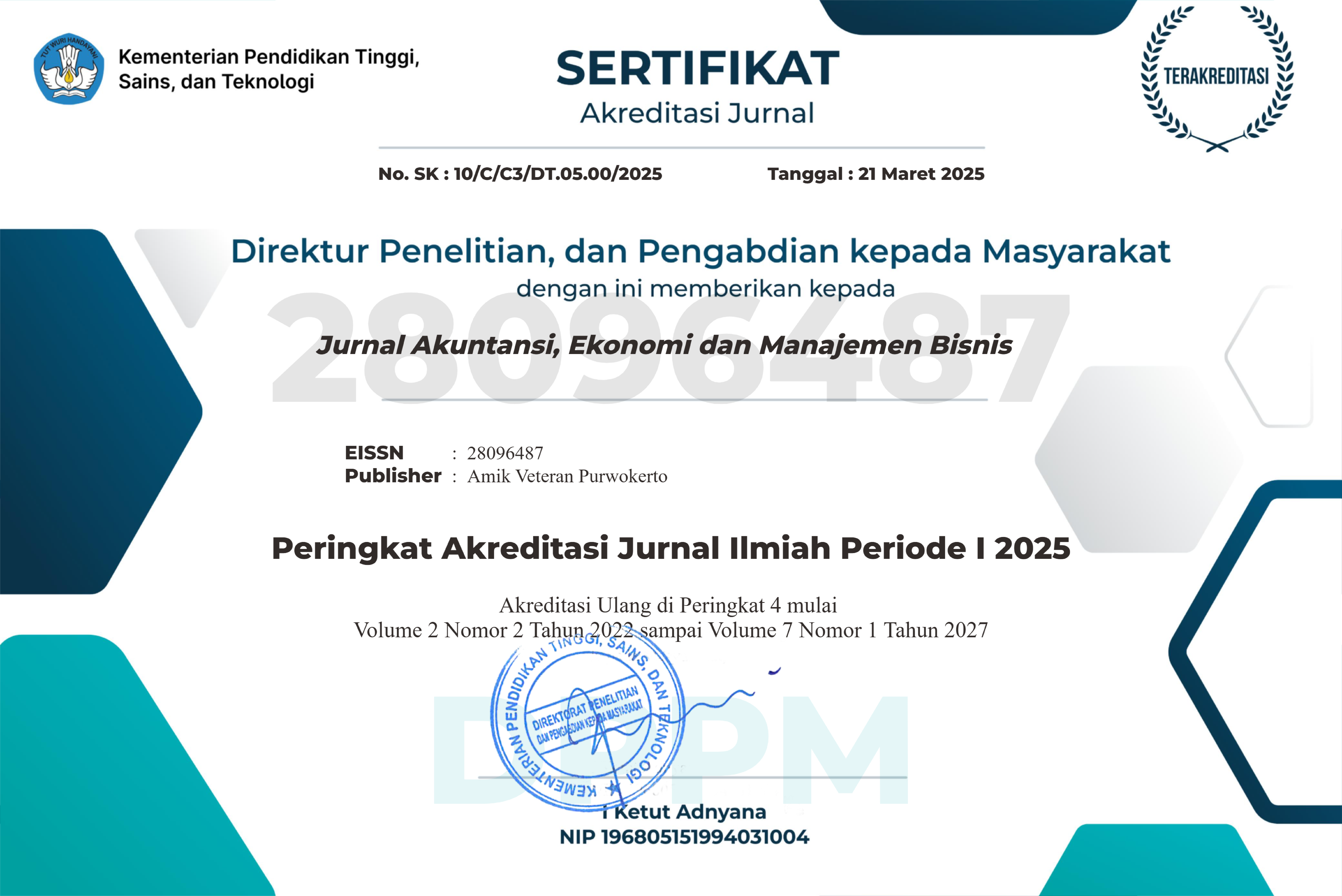Pengaruh Self-efficacy Terhadap Burnout Dengan Resilience Sebagai Variabel Mediasi Pada Karyawan PT Sapta Sentosa Jaya Abadi Mukomuko
DOI:
https://doi.org/10.55606/jaemb.v5i1.7628Keywords:
Burnout, Self-efficacy, Resilience, Palm Oil Industry, SEM-PLSAbstract
Burnout among employees in the palm oil processing industry is a critical issue that hinder productivity and organizational performance. This study aims to examine the effect of self-efficacy on burnout, with resilience as a mediating variable. A quantitative approach was employed, involving 90 empoloyees of PT Sapta Sentosa Jaya Abadi Mukomuko who completed a structured questionnaire. Data were analyzed using Structural Equation Modeling (SEM) with the Partial Least Square (PLS) method. The results indicate that self-efficacy has a significant negative on burnout. In addition, Self-efficacy positively influences resilience, which in turn significantly reduces burnout levels. The findings also demonstrate that resilience plays a mediating role in the relationship between self-efficacy and burnout. The results highlight the importance of strengthening self-efficacy and resilience as a effective strategies to prevent employee burnout, particularly in high demand industrial workplaces.
References
[1] Kemenkeu, “Industri Kelapa Sawit Berperan Strategis bagi Perekonomian Indonesia,” 2024. [Online]. Available: https://a.kemenkeu.go.id/informasi-publik/publikasi/berita-utama/Peran-Strategis-Industri-Kelapa-Sawit.
[2] R. Bianchi, E. Laurent, I. S. Schonfeld, L. M. Bietti, and E. Mayor, “Memory bias toward emotional information in burnout and depression,” J. Health Psychol., vol. 25, no. 10–11, pp. 1567–1575, 2020.
[3] A. F. Assa, “Dampak Beban Kerja Dan Lingkungan Kerja Terhadap Burnout Syndrome Pada Karyawan Pt. Sinergi Integra Services,” J. Ilm. Manaj. Ekon. Akunt. (MEA), vol. 6, no. 3, pp. 436–451, 2022.
[4] A. B. Bakker and J. D. de Vries, “Job Demands–Resources theory and self-regulation: new explanations and remedies for job burnout,” Anxiety, Stress and Coping, vol. 34, no. 1, pp. 1–21, 2021.
[5] C. Maslach and M. P. Leiter, “Burnout,” in Stress: Concepts, Cognition, Emotion, and Behavior: Handbook of Stress, 2016, pp. 351–357.
[6] W. B. Schaufeli, S. Desart, and H. De Witte, “Burnout assessment tool (Bat)—development, validity, and reliability,” Int. J. Environ. Res. Public Health, vol. 17, no. 24, pp. 1–21, 2020.
[7] WHO, “Burn-out an ‘occupational phenomenon’: International Classification of Diseases,” 2019. [Online]. Available: https://www.who.int/news/item/28-05-2019-burn-out-an-occupational-phenomenon-international-classification-of-diseases.
[8] P. M. Muchinsky, “Emotions in the workplace: the neglect of organizational behavior,” J. Organ. Behav., vol. 21, no. 7, pp. 801–805, 2000.
[9] C. Nituica et al., “Factors influencing resilience and burnout among resident physicians - a National Survey,” BMC Med. Educ., vol. 21, no. 1, pp. 1–9, 2021.
[10] S. S. Y. Ching et al., “Stressors and coping of nursing students in clinical placement: A qualitative study contextualizing their resilience and burnout,” Nurse Educ. Pract., vol. 42, p. 102690, 2020.
[11] Y. Wang and Y. Wang, “The Interrelationship Between Emotional Intelligence, Self-efficacy, and Burnout Among Foreign Language Teachers: A Meta-Analytic Review,” Front. Psychol., vol. 13, Jun. 2022.
[12] M. Makara-Studzińska et al., “Perceived stress and burnout syndrome: A moderated mediation model of self-efficacy and psychological comfort among polish air traffic controllers,” J. Air Transp. Manag., vol. 96, 2021.
[13] S. Hatuina, S. Mujanah, and A. Fianto, “Pengaruh Burnout dan Self-efficacy Terhadap Organizational citizenship behavior dan Kinerja Karyawan pada PT. Kelapa Sawit Kabupaten Sambas Kalimantan Barat,” Transformasi Manageria J. Islam. Educ. Manag., vol. 4, no. 1, 2024.
[14] J. V. Y. Nainggolan, “Hubungan Antara Stres Kerja Dengan Bunrout Pada Karyawan PTPN IV Kebun Pabatu,” Jurnal Psikologi, 2023.
[15] H. Galindo-Domínguez, M. Pegalajar, and J.-D. Uriarte, “Mediator and moderator effect of resilience between self-efficacy and burnout amongst social and legal sciences faculty members,” Rev. de Psicodidáctica (English ed.), vol. 25, no. 2, pp. 127–135, 2020.
[16] A. Bandura, Social Foundations of throught and action. Englewood Cliff, 1986.
[17] R. S. Muthi Afifah, “Hubungan antara Self-efficacy dengan Stress Kerja pada Karyawan CV. Berdikari Putra Abadi,” J. Ilm. Bimbing. Konseling Undiksha, vol. 12, no. 2, pp. 205–213, 2021.
[18] M. R. Smeds et al., “Burnout and its relationship with perceived stress, self-efficacy, depression, social support, and programmatic factors in general surgery residents,” Am. J. Surg., vol. 219, no. 6, pp. 907–912, 2020.
[19] S. Lund et al., “Jurnal Bedah Amerika,” vol. 222, pp. 1158–1162, Sep. 2021.
[20] C. C. Lebares et al., “Burnout and Stress Among US Surgery Residents: Psychological Distress and Resilience,” J. Am. Coll. Surg., 2017.
[21] F. Muhammad, S. Bahri, and H. Zuliani, “Pengaruh Dukungan Sosial Teman Sebaya Terhadap Resiliensi Remaja Di SMA Banda Aceh,” J. Bimbing. Dan Konseling, vol. 3, no. 1, pp. 1–8, 2018.
[22] P. C. Pattynama, R. Sahrani, and P. H. Heng, “Peran Regulasi Diri Dalam Belajar Dan Keterlibatan Akademik Terhadap Intensi Mengundurkan Diri Dengan Resiliensi Sebagai Mediator,” J. Muara Ilmu Sos. dan Seni, vol. 3, no. 2, p. 307, 2019.
[23] H. Cheng, Y. Fan, and H. Lau, “An integrative review on job burnout among teachers in China: Implications for Human Resource Management,” Int. J. Hum. Resour. Manag., vol. 34, no. 3, pp. 529–561, 2023.
[24] Fatin Sara, Pengaruh Burnout Kerja Terhadap Kinerja Karyawan Di Pt. Perkebunan Nusantara V Sei Galuh Kecamatan Tapung Kabupaten Kampar. 2021.
[25] D. H. Schunk and M. K. DiBenedetto, Self-efficacy and human motivation, 1st ed. Elsevier Inc., 2021.
[26] I. Capron Puozzo and C. Audrin, “Improving self-efficacy and creative self-efficacy to foster creativity and learning in schools,” Think. Skills Creat., vol. 42, Jul. 2021.
[27] R. Angriani and E. Suhartini, “Pengaruh Beban Kerja Dan Self-efficacy Terhadap Kinerja Dengan Burnout Sebagai Variabel Intervening Pada Tenaga Kesehatan Di Rs Islam Faisal Makassar,” Study of Scientific and Behavioral Management (SSBM), vol. 5, no. 1, pp. 61–79, 2024.
[28] A. Bandura, “Reflections on self-efficacy,” Adv. Behav. Res. Ther., vol. 1, no. 4, pp. 237–269, 1978.
[29] D. A. Puspitasari and M. M. H., “Hubungan Tingkat Self-efficacy Guru dengan Tingkat Burnout pada Guru Sekolah Inklusif di Surabaya,” Jurnal Pendidikan dan Perkembangan, vol. 3, no. 1, pp. 59–68, 2014.
[30] H. Jurjewicz, “How spirituality leads to resilience a case study of immigrants,” Eur. J. Sci. Theol., vol. 12, no. 4, pp. 17–25, 2016.
[31] K. M. Connor and J. R. T. Davidson, “Development of a new Resilience scale: The Connor-Davidson Resilience scale (CD-RISC),” Depress. Anxiety, vol. 18, no. 2, pp. 76–82, 2003.
[32] M. Asrun and A. M. Nurendra, “Meningkatkan Resiliensi Masyarakat Yang Terkena Phk Di Masa Pandemi Dengan Perspektif Psikologi Islam,” Motiva J. Psikol., vol. 4, no. 1, p. 32, 2021.
[33] S. Grover and A. Furnham, “Does emotional intelligence and resilience moderate the relationship between the Dark Triad and personal and work burnout?,” Pers. Individ. Dif., vol. 169, Mar. 2021.
[34] K. Reivich, The resilience factor : 7 essential skills for overcoming life’s inevitable obstacles. Montclair, NJ: Bright & Happy Books, LLC, 2002.
[35] Sugiyono, Metode penelitian bisnis: pendekatan kuantitatif, kualitatif, dan R&D, 2nd ed. Bandung: Alfabeta, 2024.
[36] S. Y. Budiarsi, “Pendampingan Pengenalan Program Sem-Pls Pada Fakultas Ekonomi Universitas Merdeka Surabaya,” PeKA J. Pengabdi. Kpd. Masy., vol. 3, no. 2, pp. 126–134, 2020.
[37] A. M. Musyaffi, H. Khairunnisa, and D. K. Respati, Konsep Dasar Struktural Equatin Model-Partial Least Square (SEM-PLS) Menggunakan SMARTPLS. Pascal Books, 2022.
[38] F. P. Santarpia, C. Consiglio, and L. Borgogni, “‘On the roots of interpersonal strain at work: The role of burnout and social self-efficacy,’” Pers. Individ. Dif., vol. 231, Jul. 2024.
[39] A. Bandura, “Social Cognitive Theory: An Agentic Perspective.,” Asian J. Soc. Psychol., vol. 2, no. 1, pp. 1–26, 1999.
[40] C. P. West et al., “Resilience and Burnout among Physicians and the General US Working Population,” JAMA Netw. Open, vol. 3, no. 7, pp. 1–11, 2020.
Downloads
Published
How to Cite
Issue
Section
License
Copyright (c) 2025 Jurnal Akuntansi, Ekonomi dan Manajemen Bisnis

This work is licensed under a Creative Commons Attribution-ShareAlike 4.0 International License.








